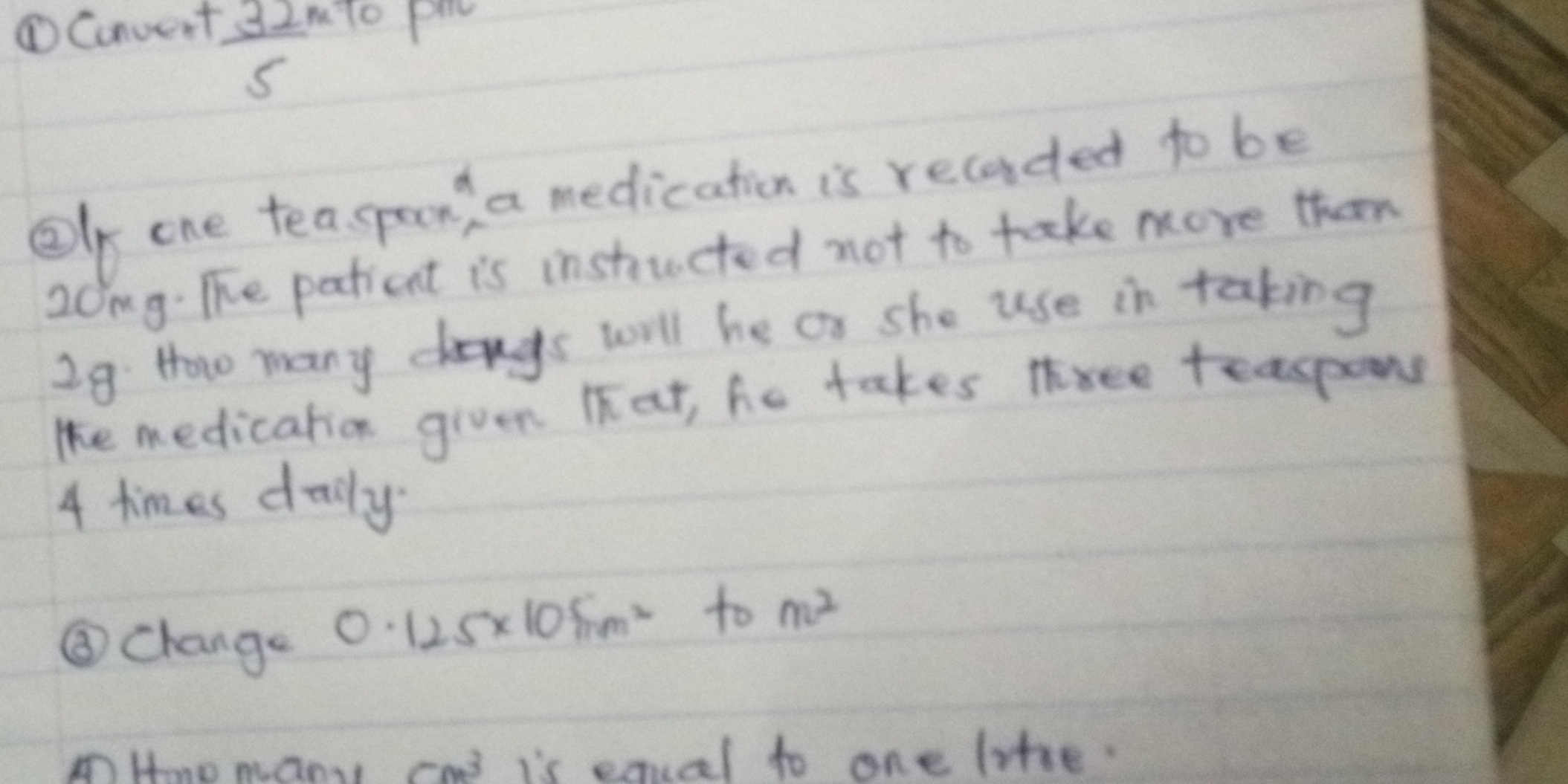Solve the following problems: 1. Convert 32/5 m to pm. 2. If one teaspoon of a medication is recorded to be 20mg. The patient is instructed not to take more than 2g. How many days... Solve the following problems: 1. Convert 32/5 m to pm. 2. If one teaspoon of a medication is recorded to be 20mg. The patient is instructed not to take more than 2g. How many days will he or she use in taking the medication given that he takes three teaspoons 4 times daily? 3. Change 0.125 x 10^5 km^2 to m^2. 4. How many cm^3 is equal to one litre?

Understand the Problem
The image presents a few different math and conversion problems.
- The first problem asks for a unit conversion from meters (m) to picometers (pm), with a fraction included.
- The second is a dosage calculation, requiring converting between grams and milligrams, and also accounting for frequency of usage.
- The third problem involves converting from square kilometers to square meters.
- The fourth problem asks how many cm^3 is equal to one litre.
Answer
1. $6.4 \times 10^{12}$ pm 2. 8 days 3. $1.25 \times 10^{10}$ $\text{m}^2$ 4. 1000 $\text{cm}^3$
Answer for screen readers
- $\frac{32}{5} \text{ m} = 6.4 \times 10^{12} \text{ pm}$
- The medication will last for 8 days.
- $0.125 \times 10^5 \text{ km}^2 = 1.25 \times 10^{10} \text{ m}^2$
- 1 liter = 1000 $\text{cm}^3$
Steps to Solve
- Convert meters to picometers
To convert meters (m) to picometers (pm), we use the conversion factor $1 \text{ m} = 10^{12} \text{ pm}$. So, we multiply $\frac{32}{5}$ meters by $10^{12}$.
$\frac{32}{5} \text{ m} = \frac{32}{5} \times 10^{12} \text{ pm} = 6.4 \times 10^{12} \text{ pm}$
- Calculate the medication dosage per day
The patient takes 3 teaspoons 4 times a day, so they take $3 \times 4 = 12$ teaspoons per day. Each teaspoon contains 20 mg of medication, so the daily dosage is $12 \times 20 \text{ mg} = 240 \text{ mg}$ per day.
- Convert the maximum allowed dosage to milligrams
The patient should not take more than 2g which is equal to $2 \times 1000 = 2000$ mg.
- Calculate the number of days the medication will last
Divide the maximum allowed dosage by the daily dosage to find how many days the medication will last. Number of days $= \frac{2000 \text{ mg}}{240 \text{ mg/day}} = 8.33$ days. Since we are looking for the number of days the medication will last, we should round this down to 8, as after 8 days worth of medication the patient will not have sufficient medication left for a ninth day.
- Convert square kilometers to square meters
To convert from square kilometers ($\text{km}^2$) to square meters ($\text{m}^2$), we use the conversion factor $1 \text{ km} = 1000 \text{ m}$. Therefore, $1 \text{ km}^2 = (1000 \text{ m})^2 = 10^6 \text{ m}^2$. Multiply $0.125 \times 10^5 \text{ km}^2$ by $10^6$ to convert to square meters:
$0.125 \times 10^5 \text{ km}^2 = 0.125 \times 10^5 \times 10^6 \text{ m}^2 = 0.125 \times 10^{11} \text{ m}^2 = 1.25 \times 10^{10} \text{ m}^2$
- Determine how many $\text{cm}^3$ are equal to one liter
1 liter is equal to 1000 milliliters (mL). 1 mL is equal to 1 $\text{cm}^3$.
Therefore, 1 liter = 1000 $\text{cm}^3$
- $\frac{32}{5} \text{ m} = 6.4 \times 10^{12} \text{ pm}$
- The medication will last for 8 days.
- $0.125 \times 10^5 \text{ km}^2 = 1.25 \times 10^{10} \text{ m}^2$
- 1 liter = 1000 $\text{cm}^3$
More Information
The prefixes used in the metric system are based on powers of 10, making conversions straightforward. Knowing these prefixes and their corresponding powers of 10 is very useful in math, physics and engineering contexts. For the dosage calculation, it's crucial to consider the units and convert them appropriately (grams to milligrams) to ensure accurate calculations. When calculating how many days the dosage will last, it's important to 'round down', because if you 'round up', the patient wouldn't have enough medication for the final 'rounded up' day.
Tips
- Forgetting to convert grams to milligrams or vice versa in the dosage calculation, leading to incorrect results.
- Making errors in the powers of 10 when converting between units like km^2 to m^2.
- Incorrectly rounding the number of days in the dosage calculation, potentially leading to an overestimation of how long the medication will last.
AI-generated content may contain errors. Please verify critical information